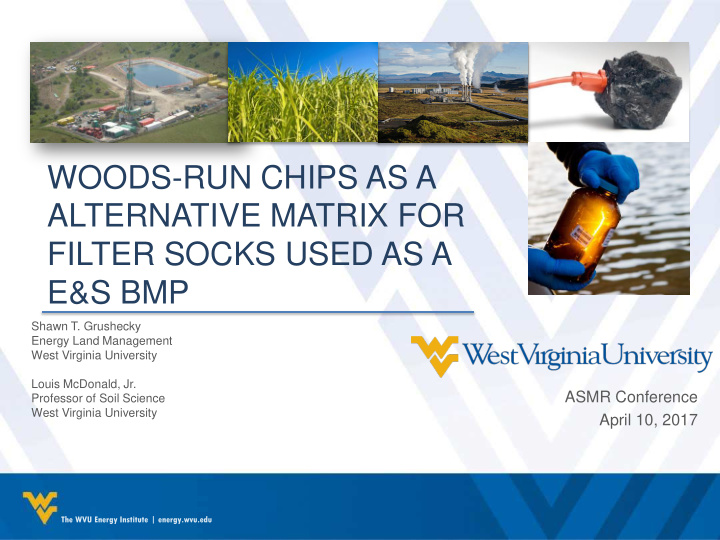



WOODS-RUN CHIPS AS A ALTERNATIVE MATRIX FOR FILTER SOCKS USED AS A E&S BMP Shawn T. Grushecky Energy Land Management West Virginia University Louis McDonald, Jr. ASMR Conference Professor of Soil Science West Virginia University April 10, 2017
Obstacles to siting unconventional wells in WV
Obstacles to siting unconventional wells in WV 1. Public opinion – nontechnical risk 2. Terrain/Environment – Regulatory • Wetlands • Streams • Endangered Species 3. Ownership
Nontechnical risk • Greater than risk associated with drilling and completion • Must be cognizant of risk before siting • Best companies understand concerns and work with local communities
Terrain • Narrow ridges • Steep slopes • Soil prone to slipping • Surface water • Coal development
Planning… • WV – 2011 HWA • Can not impound streams, discharge into streams, fill or discharge into wetlands • WV DEP and Federal EPA • Must also follow erosion and sediment control regulations • Historical and Cultural Sites • Floodplain • Warm and Coldwater streams • USFWS • Others…
WV E&S Manual – May 2012 • http://www.dep.wv.gov/oil-and- gas/Documents/Erosion%20Manual%2004.pdf • purpose is to present the best management practices (BMPs) for controlling erosion and sedimentation from soil-disturbing operations conducted during oil and gas industry activities in the state of West Virginia. • As outlined in West Virginia State Code 22-6-6(d) 22-6A-7(c), an E & S control plan shall accompany each application for a well work permit
WV E&S • Five Sections – Planning – Construction – Reclamation – Revegetation – Maintenance
WV – Sediment Control Barriers • Vegetative Filter Strip • Silt Fences • Brush Barrier • Temporary Earth or Rock Barrier • Sediment Trap or Basin • Compost filter socks • Straw Bales
PA E&S BMPS • Earth moving activities related to siting, drilling, completing, producing, servicing and plugging wells • Must follow BMPs for oil and gas well operations
PA BMPS - COMPOST • “should be a well decomposed, weed free organic matter derived from agriculture, food, stump grindings, and yard or wood/bark organic matter sources” • Compost should be aerobically composted, possess no objectionable odors and should be reasonably free (<1% by dry weight) of man made matter. • Compost should not resemble the raw material from which it was derived. Wood and bark chips, ground construction debris or reprocessed wood products are not acceptable as the organic component of the mix.
So is compost an issue?
How much sock? • On average: – 587 cubic yards needed per site – 5.87 truckloads Based on sample of 35 as constructed well sites in WV/PA
Do we have wood fiber available?
Objectives • determine if differences exist in physical size class, pH, moisture content of particles contained in composted versus woods-run materials. • evaluate differences in water filtration, solids removal, and effluent characteristics of composted versus woods-run materials
Methods • Procured filter sock material from vendors – 3 ‘certified’ composted sock – 4 ‘certified’ woods run sock • 4 socks made from each vendor – 28 total • Socks all built using same auger filler mounted on skid steer loader
Size Characteristics • 1 sock/material was sacrificed for size class/MC/pH testing • Representative samples taken from each sacrificed sock
Filtration capacity • ASTM D5141-11 Standard Test Method for Determining Filtering Efficiency and Flow Rate of the Filtration Component of a Sediment Retention Device
First Steps
Adding sediment (0.15 kg)
Release and catch filtered water
Trial
Final Wash – 2 L
Sampling filtered water
Filtering Sediment
Water Chemistry • Filtered – Whatman 42 paper • Ph and EC with electrodes • N as nitrate with colorimetry • P and K by ICP
Compost Standards
Compost - USDA
Results - MC Moisture Content 100.0 90.0 80.0 75.6 70.0 60.0 55.6 50.0 42.4 40.0 35.2 30.0 20.0 10.0 0.0 Seasoned Woods Run MCd MCw
Results – Piece Size Piece Size Analyses 97% 100% 89% 90% 80% 70% 60% 55% 50% 40% 33% 30% 20% 10% 0% Seasoned Woods Run % Pass 3/8" % Pass 1"
Results – NO 3 Average of NO3(mg/L) 0.80 0.73 0.70 0.60 0.50 0.40 0.30 0.30 0.20 0.10 0.00 SEAS WR
Results - P Average of P(mg/L) 0.70 0.65 0.60 0.50 0.40 0.30 0.20 0.10 0.08 0.00 SEAS WR
Results - K Average of K(mg/L) 5.00 4.68 4.50 4.00 3.50 3.00 2.59 2.50 2.00 1.50 1.00 0.50 0.00 SEAS WR
Results - pH Average of pH 6.80 6.78 6.78 6.76 6.74 6.72 6.70 6.68 6.67 6.66 6.64 6.62 6.60 SEAS WR
Results - conductivity Average of Cond(µS/cm) 0.40 0.35 0.35 0.30 0.28 0.25 0.20 0.15 0.10 0.05 0.00 SEAS WR
Results – Filtering Time Average Filtration Time (sec) Woods Run 93.3 Seasoned 115.3 0.0 20.0 40.0 60.0 80.0 100.0 120.0 140.0 160.0 180.0
Results – Filtration efficiency Average Filtration Efficiency (%) Woods Run 78.9 Seasoned 78.1 0.0 10.0 20.0 30.0 40.0 50.0 60.0 70.0 80.0 90.0 100.0
Overall Results Parameter Woods Run Seasoned/Compost pH Passed Passed Moisture Content Failed Dry Basis (75% vs Passed 60 %) Particle Size Passed Passed Conductivity Passed Passed No 3 Sig Higher – in Standard P Sig Higher – Outside standard K Sig Higher Filtering Time Sig Higher Filtering Efficiency Sig Higher
Conclusions • MC only parameter that woods run sock failed • No indication that WR sock installation would be detrimental to environment • In most cases, WR sock performed better than seasoned sock
Recommend
More recommend